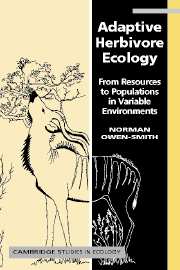Book contents
- Frontmatter
- Contents
- Acknowledgements
- Acronym and symbol conventions
- 1 Conceptual origins : variability in time and space
- 2 Consumer–resource models : theory and formulation
- 3 Resource abundance : intake response and time frames
- 4 Resource distribution : patch scales and depletion
- 5 Resource quality : nutritional gain and diet choice
- 6 Resource constraints : physiological capacities and costs
- 7 Resource allocation : growth, storage and reproduction
- 8 Resource production : regeneration and attrition
- 9 Resource competition : exploitation and density dependence
- 10 Resource-dependent mortality : nutrition, predation and demography
- 11 Habitat suitability : resource components and stocking densities
- 12 Resource partitioning : competition and coexistence
- 13 Population dynamics : resource basis for instability
- 14 An adaptive resource ecology : foundation and prospects
- References
- Index
4 - Resource distribution : patch scales and depletion
Published online by Cambridge University Press: 04 February 2011
- Frontmatter
- Contents
- Acknowledgements
- Acronym and symbol conventions
- 1 Conceptual origins : variability in time and space
- 2 Consumer–resource models : theory and formulation
- 3 Resource abundance : intake response and time frames
- 4 Resource distribution : patch scales and depletion
- 5 Resource quality : nutritional gain and diet choice
- 6 Resource constraints : physiological capacities and costs
- 7 Resource allocation : growth, storage and reproduction
- 8 Resource production : regeneration and attrition
- 9 Resource competition : exploitation and density dependence
- 10 Resource-dependent mortality : nutrition, predation and demography
- 11 Habitat suitability : resource components and stocking densities
- 12 Resource partitioning : competition and coexistence
- 13 Population dynamics : resource basis for instability
- 14 An adaptive resource ecology : foundation and prospects
- References
- Index
Summary
In the preceding chapter, we recognized a distinction between within-patch feeding and between-patch searching. However, patches may be identified at a diversity of scales. To a large extent they are generated by the feeding responses of herbivores to particular forms of heterogeneity in the vegetation. Plants occur underfoot almost everywhere, except in desert regions. Herbivores selectively consume certain plant parts and species, and forage preferentially in particular vegetation types and landscape regions (Senft et al. 1987; Bailey et al. 1996). By rejecting the intervening plant material as food, herbivores define the gaps separating patches, thereby accentuating what might be somewhat fuzzy patterns in plant distribution (Arditi and Dacorogna 1988). Even in a uniform grass sward, herbivores create a patch structure with the first bite that they take, depleting food in the spot where they fed relative to the surrounding matrix.
The handling time required to deal with food that is patchily distributed determines the asymptotic form of the classical ‘Type II’ intake response (Holling 1959, 1965). If food arrived in the form of fine particles that could be swallowed without pause, as for filter feeders like barnacles or whales, the intake rate would rise linearly with food density until digestive capacity was satiated. The clustering of plant parts into bite-sized entities causes herbivores to divert their attention from searching, even if only momentarily, to deal with the material plucked.
- Type
- Chapter
- Information
- Adaptive Herbivore EcologyFrom Resources to Populations in Variable Environments, pp. 61 - 84Publisher: Cambridge University PressPrint publication year: 2002



